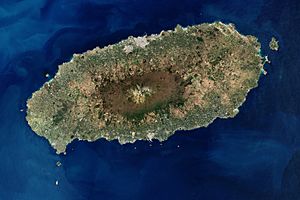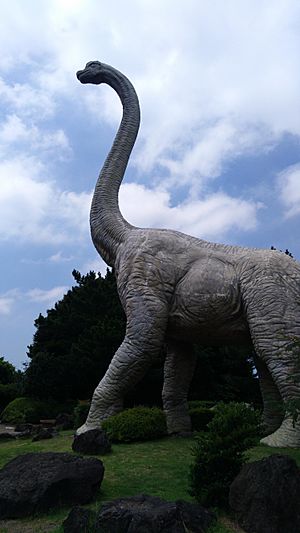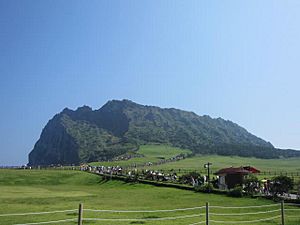Jeju-do facts for kids
Quick facts for kids
Jeju Province
|
|
|---|---|
|
Special Autonomous Province
|
|
| Korean transcription(s) | |
| • Hangul | 제주특별자치도 |
| • Hanja | 濟州特別自治道 |
| • McCune‑Reischauer | Cheju T'ŭkpyŏl Chach'ido |
| • Revised Romanization | Jeju Teukbyeol Jachido |
 |
|
| Country | South Korea |
| Region | Jeju |
| Capital | Jeju City |
| Subdivisions | 2 cities; 0 counties |
| Area | |
| • Total | 1,845.5 km2 (712.6 sq mi) |
| Area rank | 9th |
| Population
(2009)
|
|
| • Total | 565,000 |
| • Rank | 9th |
| • Density | 303/km2 (780/sq mi) |
| Metropolitan Symbols | |
| • Flower | Chamkkot |
| • Tree | Cinnamomum camphora |
| • Bird | Woodpecker |
| Dialect | Jeju |
| Website | jeju.go.kr (English) |
Jeju Island is the biggest island off the coast of the Korean Peninsula in South Korea. It is the main island of Jeju Province. The island is located in the Korea Strait, which is south of South Jeolla Province.
Jeju Island is famous for its beautiful nature. It is home to the Jeju Volcanic Island and Lava Tubes, which is a special World Heritage Site. This means it's a place recognized globally for its unique natural beauty. Jeju has a mild climate, meaning it's not too hot or too cold. Even in winter, the temperature rarely drops below freezing (0°C or 32°F). Jeju is a very popular place for holidays. A large part of the island's money comes from tourism and from its civil and naval base.
History of Jeju Island
Jeju is a volcanic island. This means it was formed by volcanoes erupting a very long time ago. The island is dominated by Hallasan, which is a volcano. Hallasan is also the highest mountain in South Korea, standing about 1,950 meters (6,400 feet) tall.
The island is about 73 kilometers (45 miles) wide from east to west. It is also about 41 kilometers (25 miles) long from north to south. Jeju Island was created by volcanic eruptions around 2 million years ago. The island is mostly made of basalt rock and lava.
Before Japan took control in 1910, Europeans often called the island "Quelpart." This name likely came from a Dutch ship called the Quelpaert. This ship saw the island by accident while sailing to Japan from Taiwan. Records show that in 1555, a group of 70 pirate ships attacked Quelpart Island. They also attacked nearby parts of the Korean peninsula.
Jeju has a humid subtropical climate. This makes it warmer than most of South Korea. In January 2016, a very cold weather event hit the region. Snow and freezing temperatures caused many problems. About 1,200 flights were cancelled on Jeju Island. This left about 90,300 passengers stuck.
Places to Visit
Jeju Island has many interesting places to explore:
- Manjanggul Lava Tube: This is a long cave formed by lava. It is 8 kilometers (5 miles) long, and you can visit 1 kilometer (0.6 miles) of it.
- Seongsan Ilchulbong or "Sunrise Peak": This is a volcanic cone with a crater. It's famous for its beautiful sunrises.
- Mount Hallasan: This is the island's main and highest peak. It's a popular spot for hiking.
- Seongeup Folk Village: Here you can see traditional Jeju houses and learn about old island life.
- Jeju Teddy Bear Museum: A fun museum with teddy bears from all over the world.
- O'Sulloc Tea Museum: Learn about tea and enjoy green tea products.
In 1993, South Korea started planning a naval base on Jeju Island. Construction began in Gangjeong village in 2007. The base was finished in 2016.
This base is called the Jeju Civilian-Military Complex Port. It was designed to be a port for both military ships and civilian cruise ships. It can hold 20 warships and 3 submarines. It can also welcome 2 large cruise ships.
Images for kids
-
Baengnokdam in Hallasan
-
Halla Mountain in Jeju
See also
 In Spanish: Isla de Jeju para niños
In Spanish: Isla de Jeju para niños












